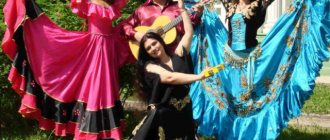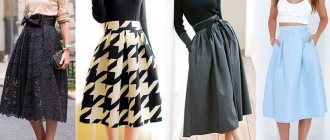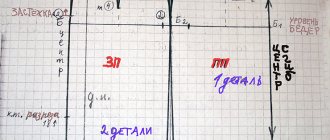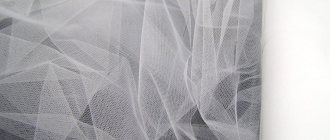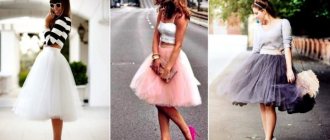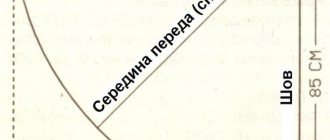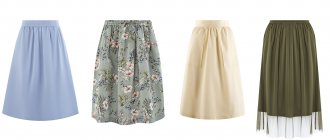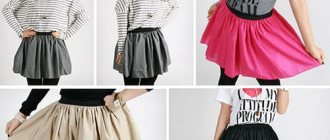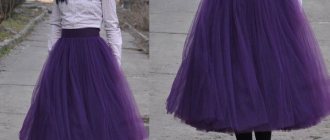Every parent wants a carnival costume to be individual and original. We present to your attention how you can sew your own gypsy costume. This outfit is perfect for any costume party, including a concert performance.
A classic suit consists of a long and wide skirt, a brightly colored blouse, a rich shawl, and heavy beads.
Necessary materials:
Canvas in rich colors; . Chiffon material black; . Black and colored bias tape; . Elastic band to make a belt approximately 6 cm wide; . Elastic band to make a frill on the bodice, the width of which is 2 cm; . Sewing supplies.
Skirt of a gypsy costume:
1.
To sew a gypsy skirt, you need to create two sun patterns - a flare, measuring the waist circumference and the desired length, taking into account that there will be a frill along the hem. We calculate the radius of the waist circumference: R = OT/2P, where OT is the waist circumference, and P is a constant value, equal to 3.14. For example: 540 mm/(2*3.14) = 86 mm. Since we need two patterns, we will divide the finished result in two, that is, 86 mm/2 = 43 mm. Then we add the length of the skirt to the calculated radius, not taking into account the frills. For example, 43 mm + 750 mm = 793 mm.
2.
We make a skirt pattern and draw it onto the material.
3.
Then carefully, without moving the material, cut the pattern.
The result is two blanks of material 150 cm each. Then we sew all the elements of the skirt. Frills: 1.
First, let's calculate the perimeter of 2 circles of the skirt, using the formula P = 2Pr, where r is the length of the skirt.
2.
for example, 2 * 3.1470 cm = 440 cm. Not forgetting that we have two blanks, the result is 440 cm * 2 = 880 cm.
3.
in the end it turns out that the frills will be 880 cm * 2 = 1760 cm, this is approximately 18 m. It turns out six strips 3 m long and 220 cm wide made of black chiffon fabric and six strips 3 m long, only 170 mm wide, made of brightly colored material.
4.
We sew the strip with a backstitch in 2 rings of 18 m each, and then decorate it with bias tape.
5.
Now we assemble the frill.
We lay the stripes (black down, bright on top) and stitch along the outside, making an indent of about 2 cm. 6.
Then distribute evenly along the entire length of the frill and stitch.
Belt:
1.
cut a piece of fabric slightly larger in length than the waist circumference and select the width to match the required elastic band for the belt. We sew the belt to the skirt, leaving a hole to install the elastic afterwards.
Top:
1.
We cut out a rectangular shape from bright fabric, the width of which is equal to two waist circumferences, and then we sew the entire thing with a bobbin elastic band.
2.
From black and bright material, we cut out strips for ruffles about 1.5 m long and decorate with bias tape.
We stitch them so that we can install the elastic later. 3.
Then we sew ruffles to the top and the suit is ready!
There are several types of similar costumes. They are all unique and similar to each other at the same time. The gypsy costume is bright, lush and memorable and will not leave anyone indifferent!
Gypsy skirts are a fairly versatile part of the wardrobe, which is suitable both as a carnival costume or for oriental dance classes, and for everyday wear.
If we consider such a skirt as an everyday one, then you can wear it with any T-shirt or blouse that matches the color. Or, in cold weather, complement the look with a knitted sweater, leather biker jacket or denim jacket.
If used as a costume for dancing, then it will perfectly emphasize all the advantages of the figure and hide its shortcomings. And the fairly loose cut does not hinder movement and even enhances the dance.
At first glance, it may seem that the manufacturing process of this product is very complicated and only a professional can handle it. In fact, basic knowledge and the ability to sew on a sewing machine is enough.
We'll tell you how to sew a gypsy skirt with your own hands.
The originality of the gypsy skirt
Features of cut, length
Reference
. The more common cut of the gypsy skirt is very simple, called “double sun”.
The peculiarity of this cut is that if you take the skirt by the edges along the side seams and lift it with outstretched arms, these edges will meet above your head, forming a circle.
The length of this product is usually half or slightly shorter, depending on the purpose. It must be taken into account that with this model the fabric consumption will be very large, usually at least 4 meters
.
Cutting details
Traditionally, two skirts are made.
- The top one is made of beautiful, bright fabric. It is very wide, usually a sun or double sun.
- The lower one may be narrower and shorter than the upper one, preferably the same color. But you can take a cheaper material, lining. The style is most often semi-sun or bell.
There is also a tiered technique, for which the length of the skirt is divided into 3-4 parts and the required number of rectangles is cut. Their width depends on the desired volume.
A circle skirt is two circles, where the larger radius is equal to the length of the product with circles cut out in the center
u. Their length is equal to the half-circumference of the waist.
Additionally, you will need a rectangular strip of fabric - a stitched skirt belt
.
If desired, there may also be frills or flounces
, which are cut out separately.
What fabrics are suitable for sewing
The choice of material for a skirt for a girl or an adult woman depends on your preferences. But you need to take into account that the volume of the skirt will be large; if sewn from thick fabrics, it will be too heavy
.
- If we are sewing a product for a carnival or dance
, we should choose light, floaty and bright fabrics. For example: satin, staple, rayon, etc. - For a casual suit,
you can choose the same materials. It is worth paying attention to plain natural and less slippery fabrics, such as cambric, linen, denim.
IMPORTANT!
If you use patterned or checkered fabric, you need to add another 20–30 centimeters to adjust the pattern at the seams.
Gypsy skirt - what is it?
Recently, double sun skirts have become very popular. They make the image of their owner incredibly romantic and feminine.
Gypsy culture has aroused interest and great curiosity for many centuries. But it was only in the mid-20th century that loose-fitting skirts began to appear on catwalks and were used in musicals, operas, etc.
The gypsy skirt has distinctive features:
- Emphasizes the figure in a favorable light;
- Suitable for all body types;
- Due to the special cut, movements in it are absolutely free and natural;
- Ideal for any holiday;
- Easily combined with modern clothing styles;
- An irreplaceable thing in gypsy style;
- It's very easy to make a skirt with your own hands;
- Has many variations to personalize the product.
A gypsy-style skirt can be made from a variety of fabric types: satin, polyester, silk, staple and others. In any case, the style will decorate your image and add relaxedness and attractiveness to your overall style.
Gypsy skirts are divided into 3 types:
- Floor-length skirt (midi). This is the most popular and classic format of such clothing. It suits any figure. In one case, the maximum length emphasizes all the advantages of the female form, in others it hides flaws. The floor-length skirt goes perfectly with a wide variety of tops, blouses and T-shirts.
- Knee length skirt. Girls who want to highlight beautiful long legs choose this option. It further emphasizes the beauty of the body, slims and decorates.
- Flared skirt. Modern fashionable option. A gypsy skirt is sewn without seams from silk or breathable knitwear.
What you need for sewing
Materials and tools
- Scissors.
- Pattern paper.
- Tape measure
- Knitted duplerin (or economy option: non-woven fabric).
- Threads.
- Base fabric.
- Pencil.
- For the belt: elastic or hidden zipper, button.
- For decoration, if desired: satin ribbons, fabric for frills, bias tape, fabric for an underskirt.
What measurements are needed to create a pattern?
To take measurements, you must clearly mark your waist. This can be done by tying it with a ribbon, preferably a narrow elastic band. Do not tighten it too tightly and place it in the narrowest area parallel to the floor.
After taking the waist measurement (F), measure the length from this line along the back. The length of the product can be any at your discretion. But usually gypsy skirts are usually made to the floor or to the ankle.
Material calculation
To calculate the material, you need to know all the measurements and the formula for calculating the radius of a small circle (waist line): R1=(From/2)/(2*π), where π is a constant equal to 3.14.
To double sun
you need two lengths plus two small radii and an additional 4–5 centimeters for allowances. This is for one half of the skirt, that is, the result needs to be multiplied by two more.
Length of frill or bias tape
for the bottom is calculated by the formula: L=2πR, where L is the circumference, R is the length of the skirt. For example, if From=60 cm and Di=75s m, then R1=(From/2)/(2*π)=(60/2)/(2*3.14)=30/6.28=4, 7 cm
2*75+2*5+5=165 cm/one half.
2*165=330 cm of fabric is needed for double sun.
IMPORTANT!
Before cutting, the fabric must undergo WTO (wet heat treatment) so that it shrinks and the finished skirt does not become small after the first wash.
If you don't have a good steamer, it won't hurt to wash the fabric before cutting.
How to make a gypsy skirt pattern
For clarity, let’s take the same measurements as for calculating the fabric:
- From=60 cm;
- Di=75 cm.
Calculate the radius of the cutout at the waist of one half of the double sun
.
R1=(From/2)/(2*π)=(60/2)/(2*3.14)=30/6.28=4.7 cm
The calculation for a larger radius looks like this.
R2=Di+R1=75+4.7=79.7 cm, this value can be rounded to 80 cm.
Draw a straight vertical line on paper, mark point A on it, from which we draw a semicircle with radius R1 = 4.7 cm. This will be the waist line of the skirt
. From point A we also mark 80 cm as often as possible and draw a second semicircle, this is the bottom. The pattern is ready.
LiveInternetLiveInternet
Quote from PIPKAlyuk's message
Read in full In your quotation book or community!
We sew a gypsy skirt.
The main principle for creating a gypsy skirt is its functionality.
A gypsy skirt should be: - Fluffy; — Colorful; - Flying; - Long, covering the legs, but not interfering with dancing.
According to the style, a gypsy skirt can be: - Double “sun” with a frill or frills. - Wedge skirt (based on the principle of a six-piece skirt) - for camp dances, where a very full skirt is not needed; — Multi-tiered skirt with frills (also mainly for camp dance).
The material for the skirt should be flowy, light, but not translucent. And also resistant to creasing and sagging. Artificial silk is ideal.
In this article we will talk about a variety or training skirt (they may differ in the quality of the material, the number of frills, decorations and the care of the seams).
Essentially, a pop gypsy skirt consists of two full suns (circles) made of fabric, with a central hole equal to the waist circumference.
The pattern of such a skirt will be too big. Therefore, you need to divide the pattern.
We offer you a pattern of one-eighth of the entire “double sun” skirt.
You need to take a sheet of paper or tracing paper with a length of two skirt lengths plus 25 cm and a width of one skirt length plus 10 cm.
Next, you need to fold the sheet in half lengthwise. Draw a 1/8 skirt pattern on it according to our pattern. (pattern)
Moreover, R (radius) will need to be calculated using the formula. If the circumference is 2πR, then R=OT/2π. OT is the circumference of our waist (measured using a string tied at the waist, quite close to the body).
As an example, my waist = 67 cm. That is. my radius of the inner circle of the pattern R will be equal to 10.67 cm (based on π = 3.14).
The length of the skirt must be calculated so that it covers the legs well, but does not get tangled during the dance. It is better to place the top of the skirt on a belt with interlining interlining for rigidity and sew in a zipper for putting it on, but in no case with an elastic band. Otherwise, the skirt may slide down, and there will be too much fabric on the waistband - gathering - which is not suitable for everyone.
The bottom of the skirt is usually trimmed with a contrasting color frill (most often it is cut on the bias, but it can also be cut straight). The width of the frill, as a rule, does not exceed 10 cm. The very bottom of the frill is also often highlighted with bright braid, which gives a unique pattern when working with a skirt.
Another important point. Ideally, a gypsy costume should also have a petticoat, because... Unlike oriental dances, in gypsy dance bare legs and navel are unacceptable vulgarity. The simplest version of a petticoat would be a separately sewn skirt - a “flared sun” (one sun!) to match the overskirt or, if the suit is light in color, white, and if the suit is black and white, then a black underskirt is appropriate. Its length should be made slightly shorter than the top one, so that when at rest it does not peek out from under the frill.
How to sew your own gypsy skirt
- Fold the fabric in half and pin the resulting pattern. The vertical line with point A lies on the fold
.
We outline with chalk taking into account the allowances and cut out two such parts. Allowances are made on the side seams of no more than 1 cm, on the bottom 1.5–2 cm. If we process it with binding, then an allowance is not needed.
If there is a frill at the bottom of the product, then its width must be subtracted from the length of the skirt and an increase must be made for stitching. - We make a product belt
. To do this, you need to cut out a rectangle, the length of which is equal to From + the increase in freedom of fit (approximately 0.5–0.7 cm). Also, don’t forget about allowances. We glue the belt with dublinin or non-woven fabric and iron it in half. - We cut the resulting circles along the grain thread on one side, these will be the side seams
.
Place the side seams of the two pieces facing inward and stitch them together using a sewing machine. You can finish the edges with an overlocker or a zigzag stitch or bias tape
. In very thin fabrics, such as chiffon, it is better to work the side seams back and forth. In this case, fold the side seams inside out and stitch them down by 0.5 cm. Iron the seam, turn it inside out and stitch by 0.5–0.7 cm. Iron the seams to the back. On the top left we leave a small space unstitched for the zipper. Usually they use a hidden one; it will be covered by the folds of the skirt and will not be noticeable at all. - Sew the belt to the waist line and sew in a zipper.
It can be sewn to the top of the product or to the waist. In the second case, we first sew in the zipper, and then the belt. At the same time, do not forget to leave an allowance for the button. - It is better to carry out the fitting of the bottom in such a product on a mannequin or on the person for whom we are sewing.
Measuring an equal distance from the floor, leave marks with chalk. On light-colored fabric, marks can be made with pins. We cut off the excess fabric and then process the bottom.
IMPORTANT!
A skirt cut using the half-sun, sun, double-sun, etc. method should be hung on a hanger or mannequin for at least a day.
Then the fabric in places along the bias will stretch to its maximum, and the bottom of the product after installation will be even. If you don’t have time for this, you can bend the bottom along the oblique part (about 1 cm shorter).
Bottom processing
You can process the bottom in three main ways.
- Moscow seam
. Complex, but when done correctly it gives a more neat look, suitable for thin fabrics. - Bias tape
. Good for thicker fabrics. If the product is made for dances or carnivals, it can be treated with a contrasting color trim to give a more aesthetic appearance. - The easiest and fastest way is to overcast the edge
, make a hem the width of the overlock stitch and topstitch by 0.1 cm.
After processing the bottom, we iron well and steam all the seams and the skirt itself.
Multi-tiered gypsy skirt
How to sew a gypsy skirt from several tiers is shown in the following diagram.
You need to measure your hips and do a few simple calculations. Don't forget about the seam allowances, and in addition to them, leave some room for the belt on the top tier.
The height of the tiers can be any. You can simply divide the length of the product by 3 to get equal cuts. But you can make them different, for example, the top one is the largest, the bottom ones are smaller. If you are planning more than three tiers, make each subsequent one about a third wider than the previous one.
It's easier to start work from the bottom. Gather the edge of the strip and form folds. Baste it to the flat edge of the smaller strip. Sew and baste the edge.
Do the same until you reach the top one. The easiest way to insert an elastic band into the waist of such a skirt. To do this, fold the edge and stitch, leaving a small hole. Insert an elastic band into it, the length of which is equal to your OT.
Useful tips
- The belt can be made with an elastic band
, but in this case it must be tight so that the skirt does not slip and holds tightly at the waist. - If the length of the skirt is more than 70 cm
, it will not fit along the length of a standard fabric with a width of 150 cm. In this case,
cut the halves of the circle
. - If you are a beginner, it is better to baste the pieces first
so that the material does not slide during stitching and there is no unnecessary fit. And then machine stitch and remove the hand seam. - The skirt can be decorated with lace, frills, bias tape or embroidered with beads and beads.
Colors should be selected depending on its purpose. - Before attaching the belt, you need to check the circumference of the waist with a measuring tape.
If it is larger than the belt, then you need to iron the fabric. To avoid stretching, you can glue the top seam allowance with a thin strip of dublerin (approximately 0.5–0.7 cm). In this case, you need to ensure that there is no unnecessary fit or stretching. - If you want to get a gathered shuttlecock, then its length should be greater than the length of the bottom. How much more depends on the build volume you want. For uniform assembly along the top of the part, we lay 2-3 auxiliary machine stitches 0.5 cm wide at a distance of 0.5 cm from each other. After stitching, remove the threads.
- The binding should be chosen to match the base material. If the base is satin or silk, then the trim should be satin. If the fabric of the skirt is staple or denim, then the trim should accordingly be cotton. The best option would be to cut it yourself from the same material as the skirt itself.
Your gypsy skirt is ready! Get into character and don't forget to take a photo!
Gypsy skirts are very beautiful and increasingly popular outfits. Gypsy skirts can be combined with different clothes, but they look especially beautiful in a gypsy costume. Today we will tell you how to sew gypsy costumes quickly and easily with your own hands.
We will try to describe the process of making a gypsy costume as simply and accurately as possible. The most difficult element of the costume is the skirt, which is sewn quite simply. Even beginners should not have any difficulties with a dance skirt, not to mention those who have sufficient sewing experience. And so, let's start sewing the main part - the skirt.
Video material
In the same way, you can sew a gypsy skirt for a girl with your own hands. For it you will need much less material, but your baby will be the star of the carnival.
We sew gypsy costumes with our own hands: the main decoration of a gypsy costume
A skirt alone can be a very beautiful item of clothing for a girl or woman. As we mentioned above, the skirt is sewn quite simply and easily. The main feature of the gypsy skirt is its large width and looseness. In the photo below you can see the approximate diameter of the gypsy skirt.
In order to get a wide skirt we need to take a large amount of fabric. We need a canvas ten meters long and one and a half meters wide. From this fabric we will make two suns and a frill along the edge. Some craftswomen sew a skirt of 2.5 suns, but it is very difficult and if you do not have enough experience, then it is better not to do this.
For your skirt, look for the lightest and loosest material possible. It should be as light as feathers. Of all the fibers, we can recommend these: satin, rayon, polyester and staple. All of them are very light, do not wrinkle and practically do not change their shape during wear. We would not advise you to use natural silk. Yes, he looks very nice, but his “tendency” to stretch will bring you a lot of trouble. A skirt made of natural silk will very quickly lose its original shape and size.
According to gypsy traditions, the skirt should fit very tightly to the girl’s waist. No bare legs or belly should be visible during the dance! Very often, many craftswomen, along with the outer skirt, also sew an inner one, the manufacture of which uses cheaper materials and, as a rule, they do not have such beautiful colors.
Sew a frill to the outer, main skirt. The frill is done in one, two, or three layers. The more layers, the heavier the skirt. But the skirt will be noticeably more beautiful. So if you're not making a skirt for dancing, you can add more layers of frill. Try to make the frill one color, this will create contrast. You can use different shapes of frill. If this is your first time sewing a skirt, then it is best for you to make a gathered frill.
Trying to make a beautiful blouse in a master class
There are many different blouses available in different shapes. You can make the sleeves tight or very wide and decorate them with waves and small frills. In modern gypsy dances, traditions have changed somewhat. If previously it was impossible to open the belly, now many dancers dance with an open belly.
A corset belt is a very beautiful and popular costume decoration. It should be made semi-rigid and not very wide. The belt beautifully emphasizes the waist and does not hinder the dancer’s movements.
A mandatory element of a gypsy costume is a shawl. The shawl serves not only as decoration, but also as a special dance accessory. The size of the shawl should be large and exceed 1.5 meters. The long length allows you to throw the shawl over your shoulders or tie it around your waist. Pavlovo Posad scarves with fringes can be used as a shawl.
In order to sew the suit, we took eight meters of printed stretch satin. The canvas had a pattern in the form of rose flowers.
Let's start sewing the suit with the skirt.
We take measurements of the waist circumference and length of the future skirt. The length of the skirt should be such that its bottom reaches the ankles.
The length of the lower tier can be made from ten to twenty-five centimeters. But first, calculate all the frills.
Be sure to step back one and a half centimeters from the edge of the skirt - we need this in order to sew on the frill. Carefully cut out and make sure that the fabric does not move. To do this, you can attach it with pins, but be careful that the pins are as sharp as possible. They may leave small puffs or burrs that are simply unacceptable.
Sew all parts of the skirt. You can sew using a closed seam, because we use thin fabric.
After that, we make frills and sew them on using a sewing machine. Next we need to straighten all the frills along the bottom of the skirt and make a beautiful belt. Our skirt is ready!
In our article, we only looked at a gypsy costume for a girl or woman. There are many articles on the Internet describing how to make a suit for a boy.
Again I answer popular questions. This time a particularly popular question is, what are my skirts made of?
I decided to talk about the fabrics that I use for sewing tribal, boho and gypsy dance skirts.
I sew gypsy skirts from different fabrics. I select them long and carefully, because they must meet a large number of parameters. Since the gypsy skirt is specific, and when sewing it many difficulties arise, the fabrics must be appropriate and these difficulties must be leveled out.
Firstly, I take light fabrics. I always make sure to check how much the fabric weighs - it’s very easy to find out this information. Secondly, the fabric is selected in such a way that it plays well in dance. When I sew flounces or frills from it, I make sure to see if they will move beautifully during the performance of the number.
Naturally, the fabric should be beautiful and bright, and also have a spectacular print. I choose only rich, interesting colors. The fabric for a gypsy skirt cannot be faded, gloomy, or “unwatchable.” Another important parameter: the fabric should be clearly visible to the audience from the stage, and, moreover, look impressive and expensive up close.
Fabric that is too heavy doesn't suit me. Because one gypsy skirt takes many meters of material, and if one meter weighs 350-400 g, then the skirt will be too heavy to lift, and it will be impossible to move in it. Therefore, fabrics such as velvet are naturally not used.
The fabric should be strong enough, but this parameter is relative. Many beautiful fabrics, for example, satin, are not very wearable and difficult to sew. Not every seamstress takes up working with them. But I love satin because it looks spectacular. Yes, it will last a little less than some other fabric, but it will look very beautiful on stage. The peculiarity of the production of this fabric allows you to obtain rich and bright colors. In addition, the shine of satin adds additional beauty to the skirt.
For a gypsy skirt, I try not to use natural fabrics, because they have their disadvantages specifically for sewing wide stage skirts.
When choosing a fabric, I always look at the composition and pay attention that the material does not accumulate static electricity, which attracts dust, hair and lint. Fortunately, many high-quality synthetic materials have now appeared that are free of this problem.
It is difficult to list the names of any specific fabrics, because the choice depends on what element will be sewn. Therefore, here I name the general points of choosing materials for skirts that are interesting to you not from the point of view of sewing them, but from the point of view of purchasing. I hope this makes it clearer what you are buying.
For tribal or boho skirts, I use cambric, a thin cotton fabric. There are quite serious restrictions in the choice of fabrics for sewing tribal models, which I do not violate. Boho style involves the use of mainly natural fabrics, but allows either some mixed fabrics (natural with synthetics) or some synthetic ones, but of good quality. I try to use natural cotton, which contains minimal addition of synthetics. Its percentage is very small, but it significantly improves the quality of the fabric: it retains colors longer, wrinkles less and, most importantly, does not shrink when washed. You probably wouldn’t want to buy a skirt of one length, and then wash it and find that it’s ten centimeters shorter. This fabric does not accumulate static electricity, it breathes and has all the other advantages of cotton.
For boho skirts, I also use viscose, which is simply irreplaceable in the summer. Viscose staple is often used - a fabric also called “silk cotton”. It is incredibly soft and fits well on the figure. If the cambric puffs up a little, the staple lays down softly, beautifully and literally flows. For many models I use it. And in the summer, on hot days, you will be cool and very comfortable in such a skirt. But please note that the staple is only suitable for everyday wear, and therefore I do not recommend choosing it for the stage.
was last modified: January 28th, 2018
How to make a gypsy costume with your own hands
If you are faced with the task of transforming yourself into a gypsy, and you don’t know how to do it, don’t despair! This costume is quite simple to reproduce; it will require things that can be found in almost every family.
To transform into a gypsy you will need
- a wide skirt, maybe even several, depending on what your gypsy will do, whether you plan to dance with wide flaps or just external resemblance is enough;
- beautiful bright colorful scarves;
- ringing voluminous decorations.
Skirts must be long. If you have a choice, it is better to take ones that are flared to the bottom. You can even use several skirts at the same time, creating a multi-layer gypsy costume from them with your own hands. In this case, one skirt may be slightly shorter; it is better to wear it on top. And let the one that is longer look out from below.
You can use a wide variety of colors, preferably bright ones, but it is better that they at least combine a little with each other. Red, green, blue, black – it’s worth choosing the most passionate shades to create a believable gypsy image.
Scarves can also help add authenticity to your outfit. With their help, you can easily make a gypsy costume with your own hands without putting in much effort. If you don’t have a bright scarf, you can probably find one in grandma’s clothes or in thrift stores. One scarf can be casually tied to your belt, and the second one can be put on your head.
Decorations should be voluminous, massive and bright. You can take more of everything. Rings, earrings, bracelets, beads should ring when dancing and even making quick movements. In this case, your DIY gypsy costume will turn out almost the same as that of real fortune tellers and cheerful dancers.
